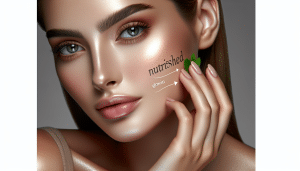Glowing Skin Secrets Most People Overlook
Ella Knight September 8, 2025
Glowing skin is not just about creams—it’s a blend of skincare, lifestyle, and nutrition choices. Unlock overlooked tips that make a visible difference in radiance, tone, and long-term skin wellness in this practical guide to everyday habits and smart routines.
Daily Habits That Influence Skin Radiance
Morning routines play a large role in setting your skin’s glow for the whole day. Cleansing gently to remove overnight oils and applying a hydrating serum with hyaluronic acid helps trap moisture, giving skin a plump, dewy look. Those who use products supporting the skin barrier—like ceramides—notice improved protection against pollutants and reduced dullness. Small details, like lukewarm water instead of hot and patting skin dry, matter more than many realize. A proper sequence is essential: cleanse, tone, treat, moisturize, and add sun protection. Following these steps in order can influence absorption and outcomes.
Nighttime rituals cannot be skipped if a radiance goal is in mind. This is when the skin repairs itself, and ingredients such as retinol and peptides are more effective. Make-up removal is non-negotiable since leftover product breeds congestion and irritation. It can be helpful to layer a nourishing face oil over moisturizer to lock in actives. Sleep quality and skincare might seem unrelated, but research confirms that a full night’s rest improves tone and firmness. A silk pillowcase can even reduce friction, leaving the face smoother upon wakening.
Consistent healthy choices outside the bathroom make skin shine from the inside out. Limiting sugar and highly processed snacks can lessen breakouts and uneven tone. Regular exercise promotes circulation, which boosts oxygen delivery and natural glow. Even light movement, such as daily walks, increases radiance when paired with a diet of antioxidant-rich fruits and vegetables. Hydration is almost as vital as topical care; those aiming for eight glasses per day often see improvements in plumpness and softness. The secret is in habits repeated each day—not just single miracle products.
The Role of Nutrition in Skin Health
What goes into the body is reflected in the skin’s brightness and clarity. Nutrients like vitamin C, found in oranges, strawberries, and peppers, support collagen production for firmness and elasticity. Omega-3 fatty acids from fish, chia seeds, and walnuts help fight inflammation, smoothing out redness and fine lines. Diets rich in leafy greens introduce helpful phytonutrients, which shield against cellular stress and slow visible aging. Those who prioritize these foods often report less dryness and more glow over time.
Recent research highlights the connection between gut health and a clear complexion. Probiotics in yogurt, kefir, and fermented vegetables balance bacteria in the digestive tract, which can reduce flare-ups of acne or eczema. Limiting dairy or sugar when experiencing frequent breakouts sometimes delivers unexpected improvements. Water remains foundational; skin cells rely on consistent hydration from within for resilience and smoothness. Fluctuations in dietary patterns tend to show up on the face faster than anywhere else.
Supplements can complement nutrition if chosen wisely. Zinc may reduce inflammation and control oil, while biotin supports cell renewal. However, experts often stress that real foods provide a richer mix of nutrients than pills alone. Those interested in advanced strategies sometimes undergo personalized nutrient testing, but simple meal changes deliver benefits to most. Paying attention to what helps or hinders individual results—and tracking with a skin journal—helps tailor nutrition for a brighter, more even tone.
Understanding Skincare Ingredients and Labels
The ingredient list on a skincare product reveals much about its effectiveness. Knowing key actives—like niacinamide for reducing pores or vitamin E for calming irritation—empowers smarter purchases. Avoiding harsh sulfates and denatured alcohols prevents unnecessary dryness or rebound oiliness, which can sabotage glow goals. Gentle exfoliants, such as lactic acid, sweep away dull surface cells, revealing new skin beneath. But moderation is crucial; overuse can lead to redness and sensitivity.
Many formulas include botanicals or ‘clean’ labels, but their real impact varies widely. Reading beyond front-label claims to understand concentration levels, pH, and dermatologist recommendations enhances safety and results. Some antioxidants—like green tea extract—provide extra environmental protection. Meanwhile, fragrance-free or hypoallergenic categories offer peace of mind for sensitive types prone to redness or breakouts. Consumer awareness is rising, and ingredient transparency is more available today than ever.
Developing a routine based on skin type matters more than chasing trends. Oily, dry, or combination skin needs tailored care to avoid imbalances. Consultation with a licensed dermatologist or esthetician provides clarity for ingredient choices, especially when managing chronic issues like rosacea or adult acne. Patch-testing new formulas before full use prevents surprises. Understanding that ‘natural’ doesn’t always mean gentle, and ‘chemical’ doesn’t always mean harsh, leads to more balanced decisions and healthier skin in the long term.
Lifestyle Factors Impacting Long-Term Beauty
Stress management is often an overlooked beauty strategy. Chronic stress can trigger hormonal changes that show up on the face—think dullness, puffiness, and breakouts. Relaxation rituals like meditation, yoga, or mindful breathing exercises lower cortisol and encourage healing from within. Many find their skin clears faster and retains moisture better when stress is kept in check. Adequate sleep and emotional wellness go hand-in-hand with healthy skin.
Environmental protection is both topical and behavioral. Consistent SPF application on exposed skin prevents premature aging and discoloration. Sunglasses, hats, and even UV-ray-blocking tech clothing add another layer, especially for those spending time outdoors. Limiting screen exposure in the evening, as blue light can disrupt circadian rhythms, indirectly supports collagen renewal and overall radiance. Those who balance digital habits with outdoor time often see improvements in skin tone and mood.
Integrating mindful movement and sweating into each week keeps skin vibrant. Activities that raise heart rate promote detoxification, as perspiration helps eliminate impurities. Post-exercise routines—like washing sweat promptly—can prevent clogged pores. Balancing rigorous exercise with gentler stretching supports circulation without strain. Many find that their skin gains a more even color and subtle glow from regular activity combined with mindful recovery, such as cooling facial masks or herbal teas.
Exploring Emerging Trends in Glowing Skin Care
New technologies and skincare protocols offer additional options for healthy, radiant skin. Popular treatments in dermatology clinics such as LED light therapy or microneedling stimulate collagen at deeper levels, improving texture and resiliency. At-home skincare tech—like sonic cleansers—makes professional techniques more accessible. Some opt for facial massages or sculpting tools to boost lymphatic drainage and reduce puffiness, discovering visible results with consistent use.
Social media communities and influencers often preview the latest ideas, but trends like glass skin or skin cycling require realistic expectations. Patch-testing before trying viral hacks is essential. Professional advice, such as consulting an esthetician or reviewing clinical studies, helps separate safe, effective ideas from those better left untried. Digital resources, including online skin analysis tools, further help users match regimens to individual needs.
Natural alternatives and sustainability are on the rise in the beauty sphere. Individuals are increasingly drawn to products with eco-friendly packaging, cruelty-free certifications, or renewable ingredients. These choices support both personal glow and planetary wellness. Experimenting with homemade facial masks using oats, honey, or yogurt is a growing trend for those wanting a DIY approach. Understanding what works for unique skin—sometimes through trial, error, and observation—remains central to any radiant skin journey.
Balancing Expectations and Building Confidence
Pursuing glowing skin is about consistency more than perfection. Media and advertising can shape unrealistic standards, but real skin has texture, pores, and minor blemishes. Celebrating progress—such as better hydration or fewer breakouts—inspires ongoing care without added pressure. Being patient with new routines allows skin to adjust naturally over several weeks, rather than expecting instant changes.
Confidence stems from understanding that wellness and beauty are deeply connected. Mental health support, positive self-talk, and social networks play tangible roles in how individuals feel about their skin. Embracing individual quirks or age-related changes fosters self-acceptance. Sharing experiences with friends or supportive groups can make the glow journey more enjoyable and less isolating, leading to both inner and outer radiance.
Tracking changes with photos or journals allows a personal record of growth. Seeking guidance from qualified professionals provides tailored reassurances and guidance, particularly for persistent concerns. Ultimately, glowing skin is a reflection of overall wellbeing, self-care, and the mindful choices repeated every day. It is more than just a surface goal—it is a lifestyle that evolves and empowers over time.
References
1. American Academy of Dermatology Association. (n.d.). Skin care: Tips for healthy skin. Retrieved from https://www.aad.org/public/everyday-care/skin-care-basics/care/healthy-skin
2. Harvard Health Publishing. (n.d.). The nutrition and skin connection. Retrieved from https://www.health.harvard.edu/staying-healthy/the-nutrition-and-skin-connection
3. Mayo Clinic. (n.d.). Healthy skin: The role of diet and nutrition. Retrieved from https://www.mayoclinic.org/healthy-lifestyle/adult-health/in-depth/skin-care/art-20048237
4. National Institute of Arthritis and Musculoskeletal and Skin Diseases. (n.d.). Skin care and aging. Retrieved from https://www.niams.nih.gov/health-topics/skin-health
5. Cleveland Clinic. (n.d.). 15 tips for healthy, glowing skin. Retrieved from https://health.clevelandclinic.org/healthy-skin-tips
6. Johns Hopkins Medicine. (n.d.). 5 ways to improve your skin health. Retrieved from https://www.hopkinsmedicine.org/health/wellness-and-prevention/5-ways-to-improve-your-skin-health







